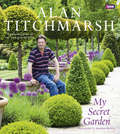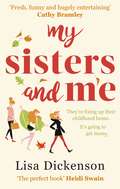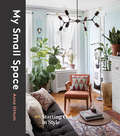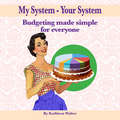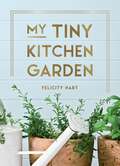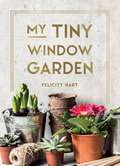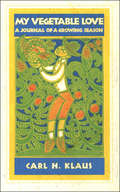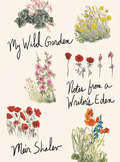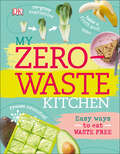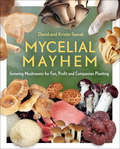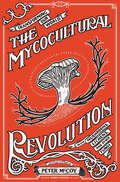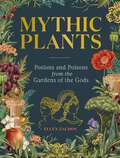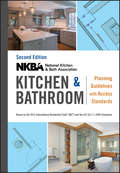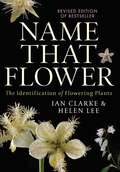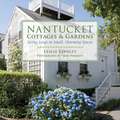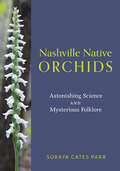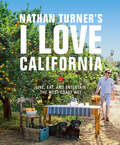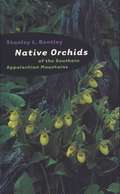- Table View
- List View
My Secret Garden
by Alan TitchmarshAfter moving from the Barleywood garden where he hosted BBC Gardeners' World for seven years, Alan Titchmarsh set up home in an old farmhouse a few miles down the road, and went about planting his own private eden away from the public eye. In this horticultural memoir Alan finally reveals all about this secret garden, explaining with his trademark warmth the personal stories behind its design and evolution. Accompanied by beautiful photographs taken by Jonathan Buckley throughout the eight years in which the garden has been made, My Secret Garden allows us access to all of the successes and failures of this diverse and ambitious project.Comprising many different styles and spaces - from an acre of formal beds and ponds to wild flower meadows and a stunning winter garden - Alan's tales of development and cultivation will be applicable to all gardeners. With the plot encompassing fruit trees, a handsome greenhouse and wildlife-friendly plantings, gardeners of all styles and levels of expertise will find something to enjoy. Driven by Alan's infectious and informative style, My Secret Garden is a fascinating, amusing and inspiring book.
My Sisters And Me: THE Hilarious, Feel-Good Book To Curl Up With
by Lisa DickensonMeet the Lake sisters... 'Fresh, funny and hugely entertaining' CATHY BRAMLEY'The perfect book!' HEIDI SWAIN'Cracking, cosy, emotional and witty'KIRSTY GREENWOOD 'You are all going to completely fall in love with this story' HOLLY MARTIN 'A feel-good hoot of a read' HEAT The BRAND NEW feel-good, kick-ass novel about sisterhood and second chances. Perfect for fans of Sophie Kinsella, Lindsey Kelk, Mhairi McFarlane and Anna Bell. **** They're fixing up their childhood home. It's going to get messy. When Willow Lake asks her daughters for help renovating the family home, each has a reason to hesitate about returning to Maplewood . . . For quiet and bookish Emmy going back to the town that ridiculed her fills her with dread. The youngest Noelle is perfectly comfortable in herself now, but once wanted to fit in so badly that she walked away from her first love. A first love who still lives in Maplewood. And outspoken Rae is painfully aware of how much the townspeople hurt her little sisters growing up. She didn't protect them then, but there's no way she'll let history repeat itself. The sisters agree to go home and make the best of it. After all if they've changed over the years, it's possible the townspeople have too . . . isn't it? The BRAND NEW feel-good, kick-ass novel about sisterhood and second chances. Perfect for fans of Sophie Kinsella, Lindsey Kelk, Mhairi McFarlane and Anna Bell. Praise for Lisa Dickenson 'PERFECT' - Miranda Dickenson 'FLAWLESS' - Holly Martin 'Sprinkled with humour' - Cathy Bramley 'HILARIOUS' - Fabulous 'Will have you laughing out loud... A must read' - Daily Express 'DELICIOUS' - Jo Thomas 'A classic' - Sun 'SPARKLING' - Sunday Express 'Feisty, fun, and fierce!' - Ali McNamara 'HEART-WARMING' - Red 'Perfect poolside reading' - The Lady 'LOVELY' - Marie Claire 'UPLIFTING' - Bella
My Sisters And Me: The hilarious, feel-good novel about sisterhood and second chances
by Lisa DickensonFrom the author of You Had Me at Merlot***THE 2018 KINDLE BESTSELLER***'You are all going to completely fall in love with this story' Holly Martin'Utterly fabulous, effortlessly modern, totally irresistible' HeatThe BRAND NEW feel-good, kick-ass novel about sisterhood and second chances. Perfect for fans of Sophie Kinsella, Lindsey Kelk, Mhairi McFarlane and Anna Bell. Available to PRE-ORDER now in paperback and ebook**** They're fixing up their childhood home. It's going to get messy. When Willow Lake asks her daughters for help renovating the family home, each has a reason to hesitate about returning to Maplewood . . . For quiet and bookish Emmy going back to the town that ridiculed her fills her with dread. The youngest Noelle is perfectly comfortable in herself now, but once wanted to fit in so badly that she walked away from her first love. A first love who still lives in Maplewood. And outspoken Rae is painfully aware of how much the townspeople hurt her little sisters growing up. She didn't protect them then, but there's no way she'll let history repeat itself. The sisters agree to go home and make the best of it. After all if they've changed over the years, it's possible the townspeople have too . . . isn't it?The BRAND NEW feel-good, kick-ass novel about sisterhood and second chances. Perfect for fans of Sophie Kinsella, Lindsey Kelk, Mhairi McFarlane and Anna Bell.Praise for Lisa Dickenson 'PERFECT' - Miranda Dickenson 'FLAWLESS' - Holly Martin 'Sprinkled with humour' - Cathy Bramley 'HILARIOUS' - Fabulous 'Will have you laughing out loud... A must read' - Daily Express 'DELICIOUS' - Jo Thomas 'A classic' - Sun 'SPARKLING' - Sunday Express 'Feisty, fun, and fierce!' - Ali McNamara 'HEART-WARMING' - Red 'Perfect poolside reading' - The Lady 'LOVELY' - Marie Claire 'UPLIFTING' - Bella
My Small Space: Starting Out in Style
by Anna OttumMy Small Space is the ultimate guide to moving out on your own--whether that's in a campus dorm, an apartment with four of your friends, a two-bedroom with your buddy, or your very own studio. With photography of all kinds of spaces, smart design tips, interviews with renters, and more, this book proves that size doesn't matter when you have great style.Learn how to decorate around immovable furniture in a dorm and what to pack (and leave behind) from home. Get creative in a cramped apartrment that you share with others. If you're thinking about living solo, see what it's like to finally be in control of all of the decision making. With tips on making floor plans, picking out color palettes, hanging wall art, choosing a rug, and more, this lookbook will help you feel right at home--wherever that may be.
My System – Your System
by Kathleen WalterThis BOOK can put you on track with your finances! $$ YOUR SYSTEM $$ Not the bank's SYSTEM, not my SYSTEM, YOUR own personal SYSTEM! Do you want to remove any financial stress that you may have?• My System is set up for you to make it Your System for the future, your future. Do you want to know how to CRUNCH your hard earned $$$$.• Well this easy budgeting SYSTEM is for you. How much money do I need to put this in place?• Your OWN incoming $$$$ is all you need to set this up. How much money do I need to put this in place?• My book explains My System, designed by myself in 1977 & it's never let me down. Do I need a computer?• NO, Manual or Spreadsheet, it's your choice. What if My System - Your System does not work for me?• My System does have in place a purpose, budgeting. My System does need you to restrain from going off track, or it will not succeed, the good news is you can always start again. What is the purpose of this book?To know where any incoming $$$$ went. How it is spent? Maybe adjustments can be made to make it better? Can my system allow for a holiday, pay extra on the home loan? Allow extra spending money? So once the most important FINANCIAL AREAS are covered, one can see on paper exactly how the finances are building up and will continue to do so! It is fun, to hold the purse strings, you will feel secure, positive, and have control of what money you have, where it's going, what you need to do, and, above all, you will accomplish discipline, strength within yourself, confidence and an amazing new attitude towards spending. The purpose of putting this in print is to help others to be financially free, not to be financially stressed! You never have to worry about your financials again, as once in place, you can adjust to suit your lifestyle as it changes, also your income, whether it increases or decreases.
My Tiny Kitchen Garden: Simple Tips to Help You Grow Your Own Herbs, Fruits and Vegetables
by Felicity HartYou don’t need a garden to grow your own food! This book is the perfect beginner’s guide to micro-gardening, featuring tips on how to start, what to choose and how to grow over 20 types of plant for your kitchen.Have you ever been curious about growing your own food? Do you lack a garden? Have you got limited space in your home? Then this book is for you!Whether you want to produce fresh herbs for your cooking, save money on your food bill, reduce your carbon footprint or enjoy the simple pleasure of watching something grow, My Tiny Kitchen Garden is bursting with tips and ideas to help you get started, including:The basics of micro-gardeningTroubleshooting tipsPlant profiles to help you choose what to growCraft ideas to help you style your plantsAdvice on growing food from scrapsHow to save and store seedsWhether you’re a budding gardener or a seasoned expert looking for seeds of inspiration, dive into this book to hone your green fingers and cultivate your very own tiny kitchen garden.
My Tiny Kitchen Garden: Simple Tips to Help You Grow Your Own Herbs, Fruits and Vegetables
by Felicity HartYou don’t need a garden to grow your own food! This book is the perfect beginner’s guide to micro-gardening, featuring tips on how to start, what to choose and how to grow over 20 types of plant for your kitchen.Have you ever been curious about growing your own food? Do you lack a garden? Have you got limited space in your home? Then this book is for you!Whether you want to produce fresh herbs for your cooking, save money on your food bill, reduce your carbon footprint or enjoy the simple pleasure of watching something grow, My Tiny Kitchen Garden is bursting with tips and ideas to help you get started, including:The basics of micro-gardeningTroubleshooting tipsPlant profiles to help you choose what to growCraft ideas to help you style your plantsAdvice on growing food from scrapsHow to save and store seedsWhether you’re a budding gardener or a seasoned expert looking for seeds of inspiration, dive into this book to hone your green fingers and cultivate your very own tiny kitchen garden.
My Tiny Window Garden: Simple Tips to Help You Grow Your Own Indoor or Outdoor Micro-Garden
by Felicity HartYou don't need a huge space to have a beautiful garden! This book is the perfect beginner's guide to micro-gardening, featuring tips on how to start, what to choose and how to grow over 20 types of indoor and outdoor plants.Have you ever been curious about gardening, but lacked an outdoor space? Or are you a pro gardener looking for your next creative horticultural challenge? Then this book is for you!Whether you want to attract local pollinators, grow a handy collection of herbs for your kitchen, create a relaxing indoor oasis, or enjoy the simple pleasure of watching something grow, My Tiny Window Garden is bursting with tips and ideas to help you get started. You will find: The basics of micro-gardening Troubleshooting tips Plant profiles to help you choose what to grow Craft ideas to help you style your plants Perfect for both budding gardeners and seasoned experts looking for seeds of inspiration, this book will hone your green fingers and help you cultivate your very own tiny window garden.
My Tiny Window Garden: Simple Tips to Help You Grow Your Own Indoor or Outdoor Micro-Garden
by Felicity HartYou don't need a huge space to have a beautiful garden! This book is the perfect beginner's guide to micro-gardening, featuring tips on how to start, what to choose and how to grow over 20 types of indoor and outdoor plants.Have you ever been curious about gardening, but lacked an outdoor space? Or are you a pro gardener looking for your next creative horticultural challenge? Then this book is for you!Whether you want to attract local pollinators, grow a handy collection of herbs for your kitchen, create a relaxing indoor oasis, or enjoy the simple pleasure of watching something grow, My Tiny Window Garden is bursting with tips and ideas to help you get started. You will find: The basics of micro-gardening Troubleshooting tips Plant profiles to help you choose what to grow Craft ideas to help you style your plants Perfect for both budding gardeners and seasoned experts looking for seeds of inspiration, this book will hone your green fingers and help you cultivate your very own tiny window garden.
My Vegetable Love: A Journal of a Growing Season (Bur Oak Original Ser.)
by Carl H. Klaus&“Home gardeners, cooks and nature lovers will savor this delightful account&” of a journey from first spring planting to final fall harvest (Publishers Weekly). My Vegetable Love is a daily record of a growing season in Iowa—but it&’s about much more than planting peppers, tending tomatoes, or harvesting eggplants. It&’s about all the things that influence this gardener: the weather, the neighborhood, his wife&’s possibly recurring cancer, the changing nature of the academic community. It&’s about the last months of his twenty-year-old cat, about his dog, and about all the other humans and animals in his gardening world. And about his family: the aunts and uncles who cared for and fed a six-year-old orphan, and helped him understand that good food was a way of knowing that someone cared. In all the gardens he has tended, the dills he has pickled, and the dinners he has cooked, Carl H. Klaus has tried to carry on that tradition and pass it on to his own children—and in this &“delectable&” book, he shares it with us as well (Publishers Weekly). &“Part Gilbert White, part Henry David Thoreau, this chronicle of an Iowa gardener&’s year has drawn from the heartland a calm, compassionate harvest.&” —Roger B. Swain, host of PBS&’s Victory Garden &“Wholeheartedly celebrates friendship, love, pets, the elements of family, academia, cooking, eating—and of course, gardening . . . Bon appétit—and good reading.&” —Smithsonian
My Wild Garden: Notes from a Writer's Eden
by Meir ShalevA colorfully illustrated round of the season in the garden of the best-selling novelist, memoirist, and champion putterer with a wheelbarrow On the perimeter of Israel&’s Jezreel Valley, with the Carmel mountains rising up in the west, Meir Shalev has a beloved garden, &“neither neatly organized nor well kept,&” as he cheerfully explains. Often covered in mud and scrapes, Shalev cultivates both nomadic plants and &“house dwellers,&” using his own quirky techniques. He extolls the virtues of the lemon tree, rescues a precious variety of purple snapdragon from the Jerusalem–Tel Aviv highway, and does battle with a saboteur mole rat. He even gives us his superior private recipe for curing olives. Informed by Shalev&’s literary sensibility, his sometime riotous humor, and his deep curiosity about the land, My Wild Garden abounds with appreciation for the joy of living, quite literally, on Earth. Our borrowed time on any particular patch of it is enhanced, the author reminds us, by our honest, respectful dealings with all manner of beings who inhabit it with us.
My Zero-Waste Kitchen: Easy Ways to Eat Waste Free
by Kate TurnerLearn how to reduce food waste with quick tips and simple solutions in My Zero-waste Kitchen.Live sustainably and embrace the three R's: reduce, reuse, and recycle. In My Zero-waste Kitchen, find creative and unexpected ways to eliminate trash, save money, and give leftovers a new life. Plus, learn how to grow your own vegetables and herbs from scraps, and how to nourish your plants with compost.With 15 nutritious and versatile recipes in which nothing goes to waste, this guide shares the secrets to smart shopping, meal planning, and the nutritional value of often-discarded food products. Turn beetroot peelings into delicious falafel, pesto, or a melt-in-your-mouth cake. Revive produce nearing the end of its shelf life with "flexi" recipes—for risotto, stir-fry, smoothies, and more.The tips and tricks in My Zero-waste Kitchen show how easy it is to live more sustainably without making a complete lifestyle change.
Mycelial Mayhem: Growing Mushrooms for Fun, Profit and Companion Planting
by Kristin Sewak David Sewak“A comprehensive and personal tome on the production, business, promotion, and problem solving for the independent mushroom grower.” —Taylor Lockwood, renowned mushroom expert & photographerMost supermarket mushrooms are bland and boring; products of an industrial process which typically relies on expensive equipment and harmful pesticides. Many people would like to add more flavorful and diverse fungi to their diets, but lack the knowledge or confidence to gather or grow their own. Do-it-yourself cultivation is a fun, exciting way to incorporate a variety of mushrooms into a sustainable lifestyle.Mycelial Mayhem is a straightforward, no-nonsense resource for the aspiring mushroom grower. This practical guide cuts through much of the confusion surrounding methods and techniques, helping the hobbyist or farmer to:Select regionally appropriate species for the home garden, farm-scale production, or an edible landscapePractice sustainable, environmentally friendly cultivation techniques, such as companion planting, to combat common garden pests and diseasesChoose a successful, proven business approach to maximize profit and minimize frustrationMany people find that DIY mushroom cultivation is not nearly as complicated as they expect, but a knowledgeable and experienced mentor is crucial to success. Whether your goal is to harvest homegrown gourmet mushrooms for your table, supplement your income by selling to friends and neighbors, or start a full-fledged niche business, Mycelial Mayhem is packed with the advice and resources you need to succeed with this rewarding and valuable crop.“After reading Mycelial Mayhem’s approachable primer to this age-old art I’m ready to invite the mysterious and captivating kingdom of fungi right into my own home.” —Langdon Cook, author of The Mushroom Hunters
Mycocultural Revolution, The: Transforming Our World with Mushrooms, Lichens, and Other Fungi
by Peter McCoyDiscover the glorious world of mushrooms, lichens, and micro fungi, as described by Peter McCoy, one of today&’s foremost experts in the field. Covering the essential information and skills for identifying, cultivating, and celebrating the uniqueness of fungi, this book enables anyone to quickly and easily engage in the art and science of mycology—the study of fungi. Mycology offers vast opportunities to enhance our lives, support our communities, and heal the environment. This first-of-its-kind introductory text is accessible for anyone just getting started in mycology, as well as for those seeking a fresh perspective on this important science.Learn general mycological facts, essential information and skills for identifying common mushroom types, foraging tips, delicious recipes, a growing guide, mycoremediation (using fungi to treat contaminated areas in our environment), mushroom-based crafts, and so much more!With a foreword by Robert Rogers, author of The Fungal Pharmacy.
Mythic Plants: Potions and Poisons from the Gardens of the Gods
by Ellen ZachosIn this beautifully illustrated book that's Song of Achilles meets Secret Life of Trees, readers will discover the plants cultivated by the Greek Gods–many of which can still be experimented with today–for a myriad of uses. In Greek mythology, plants were used for tools, intoxication, warfare, food, medicine, magic, and rituals. When Prometheus stole fire from the Olympian gods and gave it to mankind, he hid it in a stalk of giant fennel. Ancient Greeks waiting to question the oracles were given cannabis as part of their cleansing rituals. A quince fruit started the Trojan war. The goddess Demeter was so distraught when Hades kidnapped her daughter that she caused winter to blanket the earth, killing all plants. Mythic Plants focuses on how the ancient Greeks used plants in their lives and loves and conquests—some of which we can still use. Includes tips throughout for bringing these ancient plants into your garden.
NIFTY: Money-Saving Hacks and Easy DIYs for a Clean and Clutter-Free Home! (NIFTY)
by NiftyDiscover NIFTY™ tips and tricks for keeping every inch of your home neat and tidy. These innovative hacks will transform your space—and your life—in no time. Brought to you by BuzzFeed&’s insanely popular NIFTY™.It&’s time to get organized! From straightening out your kitchen drawers and maximizing closet space to keeping your home clean and tidy, the tips, tricks, and hacks in NIFTY™: Clean & Organized will take your space to the next level in no time. From the popular BuzzFeed lifestyle destination NIFTY™, this home organization guide is perfect for anyone who wants to bring a little order to whatever space they call home. It includes helpful advice on how to clean and organize every room in the house, making life easier, more organized, and less stressful than ever before. With money-saving tips, fun DIYs, and inventive ideas for maximizing space, this book is the ultimate cleaning resource. Whether it&’s tackling the chaos of the bedroom closet or making the most out of the limited space in your tiny bathroom, NIFTY™: Clean & Organized makes tidying up and staying organized easier than ever.
NKBA Kitchen and Bathroom Planning Guidelines with Access Standards
by NKBA (National Kitchen and Bath Association)The essential kitchen and bath design reference, updated with the latest codes NKBA Kitchen & Bathroom Planning Guidelines with Access Standards is the industry standard reference, written by the National Kitchen and Bath Association and updated with the latest codes and standards. This new second edition features revised guidelines for cooking surface clearance, electrical receptacles, and ventilation for kitchens, as well as ceiling height, shower size, electrical receptacles, and ventilation for bathrooms. Revised to reflect the 2015 International Residential Code and the ICC A117.1-2009, all illustrations have been expertly redrawn using 2020 Design and Chief Architect Software to provide clearer visual reference for real-world application. With thirty-one kitchen guidelines and twenty-seven bathroom guidelines, this book provides full planning recommendations, code references, and access standards for today's kitchen and bath design professional. Kitchens and bathrooms are the two most functional rooms in the house, and also the most code-intensive. It is imperative that design professionals stay up to speed on the latest guidelines to ensure the safety and efficiency of their projects. Get up to date on the latest kitchen and bath codes Reference a new range of standards for clearance, ventilation, and more Design for storage based on the results of university research Examine illustrative and descriptive plans, sections, and perspective views The NKBA guidelines are based on a composite of historical review, current industry environment and practices, emerging trends, consumer lifestyles, research, and building codes. These factors combine to help kitchen and bath professionals create designs that are beautiful, functional, accessible, and safe. The NKBA Kitchen & Bathroom Planning Guidelines with Access Standards is the complete reference professionals turn to for the latest in kitchen and bath design.
Name that Flower: The Identification of Flowering Plants: 3rd Edition
by Helen Lee Ian ClarkeName That Flower is a valued source of clear and concise information on identifying flowering plants from around the world, both cultivated and in the wild. This edition is updated to align with current systems of plant classification that incorporate advances in molecular DNA analysis. It includes more than 130 detailed line drawings, 64 colour pages and information on 46 plant families. The illustrations depict a selection of widely distributed gardens plants and weeds, and species native in eastern and southeastern Australia. Easily navigated, the book facilitates the successful use of standard identification manuals and online resources available in most parts of the world and introduces the reader to the arrangement of flowers on plants, reproduction, plant structure and function, and the way species are grouped and named. Methods for dissecting flowers and observing their structure for identification purposes are clearly described. This bestseller is used extensively as a teaching text in numerous courses concerned with the natural world, such as agriculture, horticulture, botany, environmental management and landscape design, as well as botanical art. It is an essential reference for serious gardeners and keen botanists, professional and amateur.
Nantucket Cottages and Gardens: Charming Spaces on the Faraway Isle
by Leslie LinsleyA definitive, full-color book to help bring the style of Nantucket Island into your home. There is something essentially charming about a simple cottage surrounded by a fence covered with roses. More than 1,200 of these houses can be found on Nantucket Island. Nowhere in this country are there more charming and diverse cottages featuring small pocket gardens and window boxes than on Nantucket. To a large extent, the character of the island is reflective of these little early homes. They were originally built by and for island residents at a time when islanders didn’t require, didn’t desire, or couldn’t afford anything larger. Living small, as typified by cottage living, has become the responsible, chic, innovative, and practical wave of the immediate future. Many homeowners are rethinking their needs in regard to space, opting for more quality and less quantity of space. They know that a house is more than square footage, and a small home is one that can be infused with special details and designed to accommodate the lifestyle of its occupants. Neither size nor volume has anything to do with style and comfort. The homes and gardens featured in Nantucket Cottages and Gardens reflect classic design elements that have been embraced in the past and continue to survive in the present. Throughout this book, the cottages of Nantucket will inspire those who are building new, renovating, or decorating a small home. When the quantity of space is pared down, more money can be spent on the things that give a house character, such as built-ins, weathered wood furniture, unique art pieces, and handmade textiles, to name a few.
Narcotics: Nature's Dangerous Gifts
by Norman TaylorInformation on marijuana, opium, morphine, heroin, coca, cocaine, alcohol, tobacco, ololiuqui, peyotl (mescaline), pituri, fly agaric, caapi, kava, betel, coffee, chocolate and tea.
Nashville Native Orchids: Astonishing Science and Mysterious Folklore
by Soraya Cates ParrHidden in the greenways, parks, and backyards of Nashville are several varieties of stunning native orchids. The vibrant, three-petaled flower has been revered for centuries for its exoticism and inspirational qualities. But these natural treasures, long part of a rich folk tradition, have been largely forgotten by many Nashvillians. This useful guidebook offers a comprehensive look into the secret lives of Davidson County&’s six native orchid species. Alongside vibrant, eye-catching photographs of plant life cycles that provide a straightforward way for readers to quickly identify these varieties, the book offers the fascinating history of these wild wonders as told by author Soraya Cates Parr, a passionate horticulturalist with a knack for explaining the natural world in an accessible way. More than just a useful guide to Nashville&’s flora, Nashville Native Orchids is a reminder of the risk that unbridled urban development can pose to the delicate natural ecosystem. Throughout the book, Parr shows the local effects of climate change on Nashville&’s native orchid population and advocates for a more sustainable approach to development. Beyond the environmental dimensions, this book presents an illuminating discussion of the historical significance of orchids and their central role in folkloric traditions.
Nathan Turner's I Love California: Design and Entertaining the West Coast Way
by Nathan TurnerEnjoy the California lifestyle with recipes, stylish interiors, and entertaining tips: &“A must-have for locals and visitors alike.&” —Architectural Digest Designer Nathan Turner&’s style is synonymous with the easy glam of California living. His first book introduced readers to his casual American style and chic design sense. Now, he&’s written a love letter to his home state in I Love California. This book is a journey up and down Highway 1 that takes you from the redwoods of northern San Francisco to the mountains of the Sierra Nevada to the beaches of Southern California. Simple recipes and tips for entertaining are featured alongside never-before-seen interiors. Lavish photographs capture the homes, people, and food of each unique location in glorious, sun-drenched detail. This book even includes Turner&’s signature recipes for California comfort food, like his family&’s Cioppino, Marinated Tri-tip Steak, Mexican Chocolate Cake, and more.I Love California is a celebration of the Golden State of Mind—for those interested in cooking, entertaining, décor, or just a little getaway to the sun-dappled coast.
Native Orchids of the Southern Appalachian Mountains
by Stanley L. BentleyThis authoritative guide showcases the unmatched beauty and diversity of the native orchids of the southern Appalachian mountains. Based on Stanley Bentley's many years of nature study, it covers the 52 species--including one discovered by Bentley and named after him--found in a region encompassing western Virginia and North Carolina and eastern West Virginia, Kentucky, and Tennessee.The entry for each orchid provides the plant's scientific and common names, a description of the flower (including color, shape, and size), and information on the time of flowering, range, and typical habitat, all in the context of the southern mountains. A range map accompanies each description, and Bentley's own superb photographs are an additional aid to identification.Using straightforward language yet incorporating the most up-to-date scientific information and nomenclature, the book will be welcomed by amateur naturalists or professional botanists looking for species in the field and by those who simply enjoy photographs of beautiful wildflowers.
